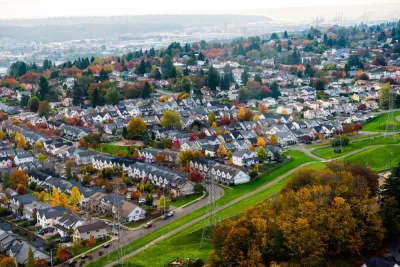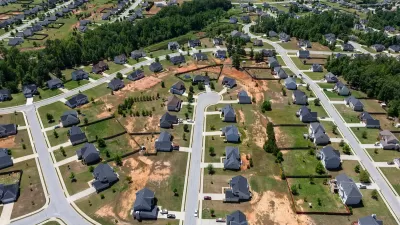The city has developed five concepts for updating its comprehensive plan to increase density and reverse the legacy of exclusionary zoning.

As Seattle updates its comprehensive plan, questions loom about how the city can prepare for a predicted population growth of a quarter million people over the next several decades. In a piece for Crosscut, Josh Cohen outlines the changes proposed so far.
“Seattle’s first comprehensive plan, adopted in 1994, established the city’s urban villages strategy. It concentrated density and new growth to neighborhood hubs along transit corridors, leaving about 75% of the city's residential areas for single-family houses.” Since then, writes Cohen, 83 percent of new homes have been built within urban village boundaries.
According to Michael Hubner, project manager for the city’s comprehensive plan update, that strategy doesn’t address “the legacy of exclusionary zoning in the city.” The city now has five options for concepts that would open up more neighborhoods to denser housing, and is seeking public input.
The comprehensive plan doesn’t set the city budget, but it establishes priorities that city officials are supposed to follow when budgeting. It doesn’t upzone neighborhoods to allow for apartment buildings or new businesses, but it shows city council members where they’re supposed to approve upzones. It’s not a transportation plan that says where new sidewalks and bike lanes will go, but the city’s transportation plan must align with the comprehensive plan.
Pro-growth advocates hope Seattle will choose the ‘Combined Plan,’ which offers the broadest range of options and could make the biggest dent in the city’s inadequate housing supply.
In 2019, Seattle officially changed the name of single-family zoning to ‘neighborhood residential zoning’ in an effort to acknowledge the diversity of the city’s neighborhoods, a step that many density advocates called purely symbolic.
FULL STORY: How Seattle is planning for a quarter million more residents

Maui's Vacation Rental Debate Turns Ugly
Verbal attacks, misinformation campaigns and fistfights plague a high-stakes debate to convert thousands of vacation rentals into long-term housing.

Planetizen Federal Action Tracker
A weekly monitor of how Trump’s orders and actions are impacting planners and planning in America.

In Urban Planning, AI Prompting Could be the New Design Thinking
Creativity has long been key to great urban design. What if we see AI as our new creative partner?

King County Supportive Housing Program Offers Hope for Unhoused Residents
The county is taking a ‘Housing First’ approach that prioritizes getting people into housing, then offering wraparound supportive services.

Researchers Use AI to Get Clearer Picture of US Housing
Analysts are using artificial intelligence to supercharge their research by allowing them to comb through data faster. Though these AI tools can be error prone, they save time and housing researchers are optimistic about the future.

Making Shared Micromobility More Inclusive
Cities and shared mobility system operators can do more to include people with disabilities in planning and operations, per a new report.
Urban Design for Planners 1: Software Tools
This six-course series explores essential urban design concepts using open source software and equips planners with the tools they need to participate fully in the urban design process.
Planning for Universal Design
Learn the tools for implementing Universal Design in planning regulations.
planning NEXT
Appalachian Highlands Housing Partners
Mpact (founded as Rail~Volution)
City of Camden Redevelopment Agency
City of Astoria
City of Portland
City of Laramie





























